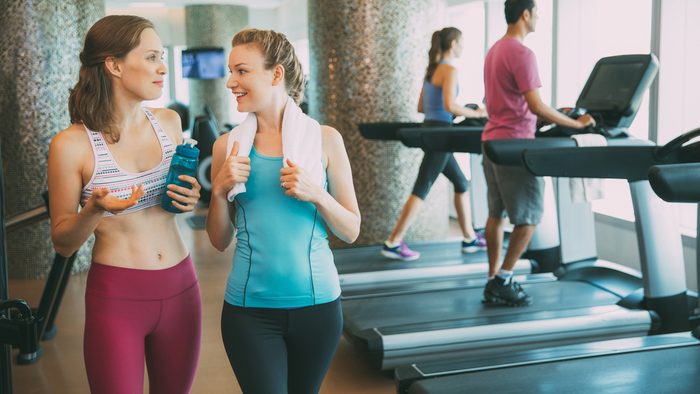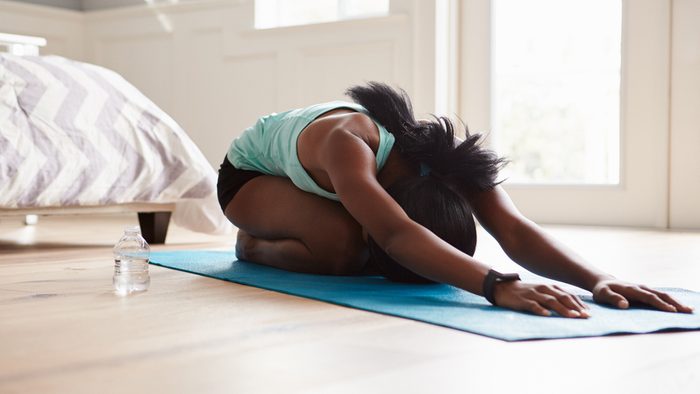
Diabetes
The Exercise Prescription: Resistance training with dumbbells, your body weight, resistance bands or gym machines + cardio
The Dose: Resistance training three times per week, plus 150 minutes of cardio exercise per week.
Exercise can improve your A1C levels, also known as your blood’s hemoglobin levels and a marker for diabetes. It can also assist in stabilizing blood glucose levels, which is vital for those living with diabetes or prediabetes. A daily workout may sound daunting, but it doesn’t have to mean a trip to the gym and it doesn’t have to be done all at once. “We see blood sugars normalize or stabilize post-exercise, so exercising throughout the day – 10 minutes here, 10 minutes there – can be beneficial,” says Hodson. To work bursts of light cardio into your day, try parking your car a few blocks away from your office. Taking the stairs and walking the dog count, too. Resistance training is also vital for those with diabetes. Studies show that an increase in muscle mass over time can have improved benefits on glycemic control, and it means that you’ll burn more calories when at rest. A good program could involve a circuit of squats, lunges, planks, push-ups and dumbbell exercises.

Dementia and Alzheimer’s Disease
The Exercise Prescription: Moderate to vigorous walking program
The Dose: 45 minutes of cardio or walking three times per week, plus three days of resistance training
Repeated studies have connected physical activity with reducing rates of dementia, improving cognition, increasing the size of the hippocampus and delaying the development of Alzheimer’s disease. A longitudinal study from the Ontario Brain Institute that examined 55 physical-activity studies and found that people over 65 who were physically active were 38 percent less likely to develop Alzheimer’s than those who were inactive – this means that one in seven cases of Alzheimer’s could be prevented with a more active lifestyle. Exercise stimulates the brain’s ability to make connections and encourages new cell growth. A separate study of seniors found that tai chi, in particular, can improve balance and coordination and slow the degenerative effects of dementia.

Heart Disease
The Exercise Prescription: Walking + resistance training
The Dose: Some form of exercise most days of the week (for 10 minutes or more) for a total of 150 minutes
a week, plus two-three days of resistance training
“Heart disease is the number one killer of women,” says Hodson. This means getting patients on a treadmill or cardio equipment, with longer warm-ups and cool-downs, and getting their blood pumping to improve circulation and blood flow, she says. If you’re not a fan of the treadmill, an evening stroll counts, too, as long as it’s a bit challenging. (If you’re not sure if you’re pushing yourself enough, use a Rate of Perceived Exertion scale, with 10 meaning you’re breathless or at the point of muscle exhaustion. For best results, aim for a seven or eight on the scale on most walks. And, of course, you don’t have to stop at walking. Running, indoor cycling and group fitness classes that challenge your heart rate are excellent forms of cardio training to work into your fitness regimen. To build strength, begin by incorporating light hand weights on the walk, working your way up to strength-training sessions twice a week. Improving muscle mass can also help battle heart disease.

Arthritis
The Exercise Prescription: Water workouts
The Dose: 30 minutes in the pool, two or three times a week
The Arthritis Foundation recommends working out in water because it provides 12 times the resistance of air, allowing you to challenge your muscles while taking it easy on your joints. To start, find a class at a local city pool that incorporates water walking or running and different underwater strength-building exercises. Swimming good old-fashioned laps at the pool will also do the trick.

Depression, Anxiety and Stress
The Exercise Prescription: Yoga + cardio
The Dose: Daily yoga plus 150 minutes of cardio exercise per week
Exercise increases endorphins and enkephalins (natural pain relievers and feel-good hormones), boosting energy and improving sleep, though the effects vary, says Dr. Manuela Joannou, a physician in Perth, ON. Dr. Joannou is the founder and medical director of Project Trauma Support, a treatment program for post-traumatic stress disorder (PTSD). “Yoga is helpful for getting you back in touch with your body and focused on the mind-body connection,” she says. “Many people with PTSD have untreated depression, so the benefits of higher feel-good endorphins are relevant.” Cardio is just as important for boosting your mood. “Increasing our heart rate via cardio elevates our internal temperature, releases endorphins and gives our prefrontal cortex (the personal assistant of our brain) a nap,” says Hodson. “All of these are key in the treatment of depression, anxiety and stress.”
A morning yoga practice of sun salutations and yoga poses can start the day off right and be done in as little as 15 minutes. Roll out a mat in your bedroom and work through a series of poses before beginning your day. Don’t be afraid to attend yoga classes either – they can be a great way to learn the poses and theory, and also to promote social connection.
